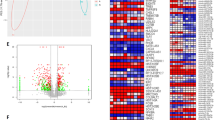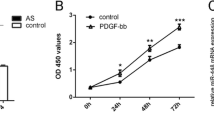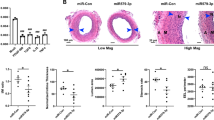Abstract
Previously we found decreased expression of SOCS3 in neointimal hyperplastic region following balloon angioplasty in atherosclerotic micro swine. In our recent in vitro studies using human coronary artery smooth muscle cells (HCASMC), we observed the inhibition of SOCS3 expression in the presence of both TNF-α and IGF-1, correlating with the in vivo findings in microswine. We also reported that two independent mechanisms, JAK/STAT3/NFκB and promoter methylation of SOCS3 were responsible for TNF-α and IGF-1 induced SOCS3 inhibition. In this study, using miRNA array and gene expression approaches, we explored the molecular mechanisms involved in the above SOCS3 repression and identified several miRNAs that are associated with the regulation of SOCS3 expression. Our miRNA expression profiling revealed profound down-regulation of two specific miRNAs, hsa-miR-758 and hsa-miR-1264, whose expression levels were decreased by 8–10 folds in HCASMCs that were treated with both TNF-α and IGF-1. This was accompanied with a significant up-regulation of three specific miRNAs, hsa-miR-155, hsa-miR-146b-5p and hsa-miR-146a, which showed about 3–7 fold increases in their expression levels. Importantly, we also found that the miRNA hsa-miR-1264 targets DNA methyltransferase-1 (DNMT1) transcripts by binding to its 3′UTR region to affect its expression. Expression of hsa-miR-1264 in HCASMCs not only resulted in decreased DNMT1 mRNA transcripts but it also increased SOCS3 expression. The treatment with TNF-α and IGF-1 resulted in drastic decrease in hsa-miR-1264 levels with no change in the expression of DNMT1. Consequently, the DNMT1 activity caused hypermethylation in the CpG island of the SOCS3 promoter region and inhibited its expression. This could be a causative epigenetic mechanism associated with TNF-α and IGF-1 induced smooth muscle cell proliferation involved in the pathogenesis of coronary artery hyperplasia and restenosis.








Similar content being viewed by others
Abbreviations
- SOCS3:
-
Suppressor of cytokine signaling-3
- HCASMC:
-
Human coronary artery smooth muscle cell
- GAPDH:
-
Glyceraldehyde 3-phosphate dehydrogenase
- DNMT1:
-
DNA methyl transferase-1
- IGF-1:
-
Insulin like growth factor-1
- TNF-α:
-
Tumor necrotic factor-α
- miR:
-
microRNA
References
Yoshimura A, Ohkubo T, Kiguchi T, Jenkins NA, Gilbert DJ, Copeland NG, Hara T, Miyajima A (1995) A novel cytokine-inducible gene CIS encodes an SH2-containing protein that binds to tyrosine-phosphorylated interleukin 3 and erythropoietin receptors. EMBO J 14:2816–2826
Barclay JL, Anderson ST, Waters MJ, Curlewis JD (2009) SOCS3 as a tumor suppressor in breast cancer cells, and its regulation by PRL. Int J Cancer 124:1756–1766
Wormald S, Hilton DJ (2004) Inhibitors of cytokine signal transduction. J Biol Chem 279:821–824
Yasukawa H, Sasaki A, Yoshimura A (2000) Negative regulation of cytokine signaling pathways. Annu Rev Immunol 18:143–164
Krebs DL, Hilton DJ (2000) SOCS: physiological suppressors of cytokine signaling. J Cell Sci 113(Pt 16):2813–2819
Monraats PS, Pires NM, Schepers A, Agema WR, Boesten LS, de Vries MR, Zwinderman AH, de Maat MP, Doevendans PA, de Winter RJ, Tio RA, Waltenberger J, ’t Hart LM, Frants RR, Quax PH, van Vlijmen BJ, Havekes LM, van der Laarse A, van der Wall EE, Jukema JW (2005) Tumor necrosis factor-alpha plays an important role in restenosis development. FASEB J 19:1998–2004
Allen TR, Krueger KD, Hunter WJ 3rd, Agrawal DK (2005) Evidence that insulin-like growth factor-1 requires protein kinase C-epsilon, PI3-kinase and mitogen-activated protein kinase pathways to protect human vascular smooth muscle cells from apoptosis. Immunol Cell Biol 83:651–667
Grant MB, Wargovich TJ, Bush DM, Player DW, Caballero S, Foegh M, Spoerri PE (1999) Expression of IGF-1, IGF-1 receptor and TGF-beta following balloon angioplasty in atherosclerotic and normal rabbit iliac arteries: an immunocytochemical study. Regul Pept 79:47–53
Gupta GK, Dhar K, Del Core MG, Hunter WJ 3rd, Hatzoudis GI, Agrawal DK (2011) Suppressor of cytokine signaling-3 and intimal hyperplasia in porcine coronary arteries following coronary intervention. Exp Mol Pathol 91:346–352
Dhar K, Rakesh K, Pankajakshan D, Agrawal DK (2013) SOCS3 promotor hypermethylation and STAT3-NF-kappaB interaction downregulate SOCS3 expression in human coronary artery smooth muscle cells. Am J Physiol Heart Circ Physiol 304:H776–H785
Robertson KD (2001) DNA methylation, methyltransferases, and cancer. Oncogene 20:3139–3155
Bestor TH (2000) The DNA methyltransferases of mammals. Hum Mol Genet 9:2395–2402
Braconi C, Huang N, Patel T (2010) MicroRNA-dependent regulation of DNA methyltransferase-1 and tumor suppressor gene expression by interleukin-6 in human malignant cholangiocytes. Hepatology 51:881–890
Fabbri M, Garzon R, Cimmino A, Liu Z, Zanesi N, Callegari E, Liu S, Alder H, Costinean S, Fernandez-Cymering C, Volinia S, Guler G, Morrison CD, Chan KK, Marcucci G, Calin GA, Huebner K, Croce CM (2007) MicroRNA-29 family reverts aberrant methylation in lung cancer by targeting DNA methyltransferases 3A and 3B. Proc Natl Acad Sci USA 104:15805–15810
Garzon R, Liu S, Fabbri M, Liu Z, Heaphy CE, Callegari E, Schwind S, Pang J, Yu J, Muthusamy N, Havelange V, Volinia S, Blum W, Rush LJ, Perrotti D, Andreeff M, Bloomfield CD, Byrd JC, Chan K, Wu LC, Croce CM, Marcucci G (2009) MicroRNA-29b induces global DNA hypomethylation and tumor suppressor gene reexpression in acute myeloid leukemia by targeting directly DNMT3A and 3B and indirectly DNMT1. Blood 113:6411–6418
Huang J, Wang Y, Guo Y, Sun S (2010) Down-regulated microRNA-152 induces aberrant DNA methylation in hepatitis B virus-related hepatocellular carcinoma by targeting DNA methyltransferase 1. Hepatology 52:60–70
Pan W, Zhu S, Yuan M, Cui H, Wang L, Luo X, Li J, Zhou H, Tang Y, Shen N (2010) MicroRNA-21 and microRNA-148a contribute to DNA hypomethylation in lupus CD4 + T cells by directly and indirectly targeting DNA methyltransferase 1. J Immunol 184:6773–6781
Wang YS, Chou WW, Chen KC, Cheng HY, Lin RT, Juo SH (2012) MicroRNA-152 mediates DNMT1-regulated DNA methylation in the estrogen receptor alpha gene. PLoS One 7:e30635
Xie C, Zhang J, Chen YE (2011) MicroRNA and vascular smooth muscle cells. Vitam Horm 87:321–339
Rajewsky N (2006) microRNA target predictions in animals. Nat Genet 38(Suppl):S8–S13
Friedman RC, Farh KK, Burge CB, Bartel DP (2009) Most mammalian mRNAs are conserved targets of microRNAs. Genome Res 19:92–105
John B, Enright AJ, Aravin A, Tuschl T, Sander C, Marks DS (2004) Human MicroRNA targets. PLoS Biol 2:e363
Krek A, Grun D, Poy MN, Wolf R, Rosenberg L, Epstein EJ, MacMenamin P, da Piedade I, Gunsalus KC, Stoffel M, Rajewsky N (2005) Combinatorial microRNA target predictions. Nat Genet 37:495–500
van Rooij E (2011) The art of microRNA research. Circ Res 108:219–234
Thomson DW, Bracken CP, Goodall GJ (2011) Experimental strategies for microRNA target identification. Nucleic Acids Res 39:6845–6853
Rice P, Longden I, Bleasby A (2000) EMBOSS: the European molecular biology open software suite. Trends Genet 16:276–277
Boosani CS, Agrawal DK (2015) Methylation and microRNA-mediated epigenetic regulation of SOCS3. Mol Biol Rep 42:853–872
Ramirez CM, Davalos A, Goedeke L, Salerno AG, Warrier N, Cirera-Salinas D, Suarez Y, Fernandez-Hernando C (2011) MicroRNA-758 regulates cholesterol efflux through posttranscriptional repression of ATP-binding cassette transporter A1. Arterioscler Thromb Vasc Biol 31:2707–2714
Lewis BP, Burge CB, Bartel DP (2005) Conserved seed pairing, often flanked by adenosines, indicates that thousands of human genes are microRNA targets. Cell 120:15–20
Kozomara A, Griffiths-Jones S (2011) miRBase: integrating microRNA annotation and deep-sequencing data. Nucleic Acids Res 39:D152–D157
Griffiths-Jones S (2004) The microRNA Registry. Nucleic Acids Res 32:D109–D111
Griffiths-Jones S (2006) miRBase: the microRNA sequence database. Methods Mol Biol 342:129–138
Griffiths-Jones S, Saini HK, van Dongen S, Enright AJ (2008) miRBase: tools for microRNA genomics. Nucleic Acids Res 36:D154–D158
Zhou H, Park S, Housman J, Elia L, Lim B, Yajima T (2009) MicroRNA-19a (miR-19a) regulates gp130 signaling by inhibiting suppressor of cytokine signaling-3 (SOCS3) protein translation. Circulation 120:S835
Persson JL (2013) miR-155 meets the JAK/STAT pathway. Cell Cycle 12:2170
Xin M, Small EM, Sutherland LB, Qi X, McAnally J, Plato CF, Richardson JA, Bassel-Duby R, Olson EN (2009) MicroRNAs miR-143 and miR-145 modulate cytoskeletal dynamics and responsiveness of smooth muscle cells to injury. Genes Dev 23:2166–2178
Liu X, Cheng Y, Zhang S, Lin Y, Yang J, Zhang C (2009) A necessary role of miR-221 and miR-222 in vascular smooth muscle cell proliferation and neointimal hyperplasia. Circ Res 104:476–487
Cheng Y, Liu X, Yang J, Lin Y, Xu DZ, Lu Q, Deitch EA, Huo Y, Delphin ES, Zhang C (2009) MicroRNA-145, a novel smooth muscle cell phenotypic marker and modulator, controls vascular neointimal lesion formation. Circ Res 105:158–166
Acknowledgments
The research awards R01HL104516, R01HL112597, and R01HL120659 from the Office of the Director, and National Heart Lung and Blood Institute, National Institutes of Health, USA to DKA supported this work. The content of this research article is solely the responsibility of the authors and does not necessarily represent the official views of the National Institutes of Health, USA.
Author information
Authors and Affiliations
Corresponding author
Additional information
Kajari Dhar—Former postdoctoral fellow.
Rights and permissions
About this article
Cite this article
Boosani, C.S., Dhar, K. & Agrawal, D.K. Down-regulation of hsa-miR-1264 contributes to DNMT1-mediated silencing of SOCS3. Mol Biol Rep 42, 1365–1376 (2015). https://doi.org/10.1007/s11033-015-3882-x
Published:
Issue Date:
DOI: https://doi.org/10.1007/s11033-015-3882-x




